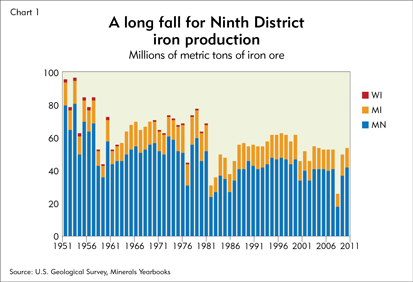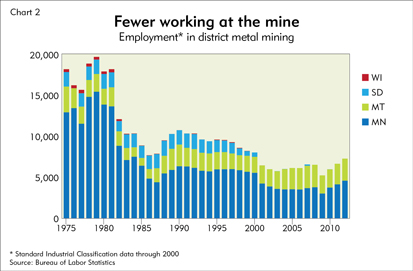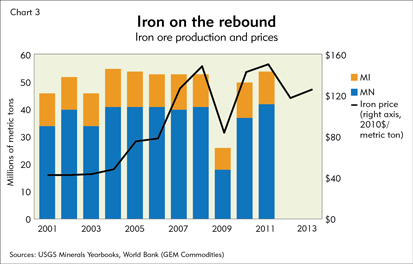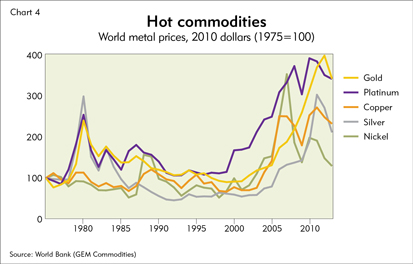The city of Hoyt Lakes, Minn., has experienced boom and bust in iron mining. Founded in the 1950s to house workers at the Erie Mining Co. taconite plant, the Iron Range community flourished with the industry; in the late 1970s, 20-odd businesses and a shopping mall catered to the needs of well-paid miners and their families.
Growth stopped and shifted abruptly into reverse in 2001, when LTV Steel Mining closed the plant—part of a painful contraction in the U.S. steel industry. The city lost 1,400 jobs and half its population as people sold their homes and moved away. Today, only two struggling retail businesses remain. “We have been hurting since 2001,” said Mayor Mark Skelton. “And then throw the recession on top of that. ... We did not weather the recession well.”
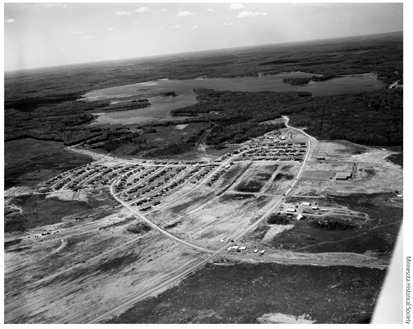
This aerial photo, taken June 15, 1955, by a Minneapolis newspaper photographer, shows the newly founded city of Hoyt Lakes, Minn., built to house workers at the Erie Mining Co. taconite plant.
Large Image
But since the Great Recession, mining has shown new signs of life on the eastern Iron Range. Four years ago, a mining start-up near Hoyt Lakes began producing high-purity iron nuggets for use in electric arc furnaces. More than 150 people, including a number of city residents, work at the Mesabi Nugget plant. And the area is seeing a new type of mining development, one that—if planned mines come to fruition—would bring massive investment and hundreds of new jobs.
Two large mines have been proposed to extract copper, nickel and other metals from billion-year-old bedrock underlying the forests between Hoyt Lakes and Ely. Together, the PolyMet and Twin Metals Minnesota projects represent $3 billion in potential capital investment on the eastern Iron Range.
PolyMet Mining of Canada plans to develop an open pit mine east of Hoyt Lakes and process the ore in LTV’s old facility, revamped for the purpose. PolyMet has said the project, in the environmental review stage, will employ up to 360 workers earning $36 million annually in wages and benefits. The PolyMet and Twin Metals projects have prompted an outbreak of blue “We Support Mining” signs and banners outside businesses and homes in Hoyt Lakes and nearby Babbitt, Minn.
“It is huge for us,” Skelton said. “I can’t put it any other way for you. Thirty-six million a year in payroll just at PolyMet—that’s awesome. What would that do for our area? An awful lot.” Skelton’s enthusiasm is tempered by the knowledge that the PolyMet and Twin Metals (an early-stage proposal for a large underground mine southeast of Ely) projects may never be built. Both face opposition from environmental groups worried about acid runoff from mine workings.
More than a dozen other new hard rock mines are either under development or have been proposed in Ninth District states (see “Hard rock café”). Projects include a copper and nickel mine nearing completion in the Upper Peninsula of Michigan; a planned uranium mine in the Black Hills of South Dakota; and proposals to mine for copper, gold and silver in western Montana.
In addition, established taconite mines on the Iron Range have ramped up their production and employment. And Magnetation LLC, a firm that produces iron from discarded ore tailings, was preparing to build an iron concentrate plant near Coleraine, Minn.—the fourth developed on the Range since 2008.
Rising commodity prices since the early 2000s are the main impetus for this mining upsurge. Copper, for example, was trading in May at almost three times the price of the metal in 2003; before a recent downturn, the price of copper was even higher. Global demand for metals has been high, “and that’s really been driven over the last decade and a half by the industrialization of the developing world,” said Patrick Barkey, director of the Bureau of Business and Economic Research at the University of Montana.
However, the spate of mining activity in the district doesn’t necessarily presage long-term industry growth. The primary customer of iron mines, the U.S. steel industry, has shrunk in recent decades.
As for nonferrous mines, how many become going concerns depends on demand for metals in rapidly developing countries such as China and, in some cases, rapprochement between mining firms and their opponents. PolyMet and Twin Metals aren’t the only mining projects in the district that are being resisted by environmental groups and area residents, including Indian tribal communities.
Related Content
Hard rock café
Map of new metal mining development in the Ninth District
Between a rock and a hard place
Wresting metals from the earth is less important economically in the district than it was a generation ago. Over the past half century, production of most types of metals has declined in district states with significant hard mineral wealth (every state except oil-rich North Dakota). The output of district iron mines, for example, has fallen by more than 40 percent since the early 1950s (see Chart 1), even as U.S. steel consumption has increased.
Comprehensive mine production data from the U.S. Geological Survey (USGS) are lacking for mining of nonferrous metals such as copper, gold, silver and platinum. But available numbers on production and mine capacity tell a similar story of overall decline. Copper mining petered out in the U.P. in the 1990s, ending 150 years of production. Montana’s output of the semiprecious metal peaked at roughly the same time and has since dropped. Production of gold and silver in Montana and South Dakota has fallen sharply from a high in the early 1990s. As hard rock mines have closed or cut production, employment has also fallen (see Chart 2).
At the same time, mining productivity has increased due to mine consolidation, advances in technology and changes in work practices. For example, research by Minneapolis Fed economist James Schmitz has shown that a relaxation of work rules due to foreign competition spurred efficiency gains in the early 1980s. This allowed employment in iron mines—which account for the bulk of metal mining employment in the district—to fall proportionately more than production.
Today, in every district state, metal mining jobs make up just a fraction of 1 percent of total employment. But mining remains economically significant in certain areas of the district, such as Minnesota’s Iron Range, the western U.P., and southwestern Montana. In 2012, Iron Range mines—which produce 80 percent of the iron used by U.S. blast furnaces to make steel—employed over 4,300 people in a part of the state with little other major industry.
In the U.P.’s Marquette County, two large iron mines operated by Cliffs Natural Resources employ about 1,600 workers. And in the small city of Butte, Mont., about 350 people work at Montana Resources, a copper, silver and molybdenum mine. Mining jobs pay well; in 2013, metal miners nationwide earned an average of $70,000 annually.
Wages and other spending by mining companies flow to local businesses and households. A 2012 study by economists at the University of Minnesota-Duluth estimated that iron mining contributed $1.1 billion in 2010 to the economy of the seven-county Minnesota Arrowhead region and neighboring Douglas County, Wis. Additional spending and jobs came from firms that supply mines with goods and services such as rail transport, electrical power, and equipment maintenance and repair.
Mining firms also pay taxes—a crucial contribution to government services in rural areas with small tax bases. In Minnesota, revenue from a tax on taconite production goes to local governments and school districts in areas where iron ore is extracted and was mined in the past. In 2013, Iron Range cities and townships received $13.9 million in production tax revenues, according to the state Department of Revenue.
Ranching is the main livelihood in sparsely populated Stillwater County in south-central Montana. By far, the largest nonfarm employer is the Stillwater Mining Co., owner of the country’s only palladium and platinum mines. In 2013, the county’s share of state taxes on mining production and sales, combined with county property taxes, amounted to $8.5 million—43 percent of total county tax revenues.
“As much iron ore as they can produce”
In 2009, Iron Range mines slashed production in response to plummeting demand for iron ore from U.S. steelmakers. Steel and iron ore prices fell, and many mine workers were furloughed. Cliffs’ Empire and Tilden mines in the U.P. also cut production. But since then, iron mining has enjoyed a mild resurgence in the district. Ore prices have rebounded, spurring increased production (see Chart 3).
Data from the USGS are available only through 2011, but more recent figures from the Minnesota Department of Revenue indicate that iron production continues to rise; the department estimated that state iron output this year will exceed 2013 production and reach the highest level since 2000.
Iron Range mines, most of which are wholly or partly owned by U.S. steel companies, have cranked up production to satisfy rising demand for motor vehicles, construction girders, household appliances and other goods made from steel. According to the World Steel Association, U.S. steel production in March increased 1 percent year over year. Steelmakers are calling upon mines “to provide as much iron ore as they can produce,” said Craig Pagel, executive director of the Iron Mining Association of Minnesota. “It’s the general uptick in the economy, whether it’s cars and trucks being purchased or homes that are starting to be built.” U.S. blast furnaces are also turning out more steel pipe used to drill wells in booming shale oil regions such as western North Dakota.
A number of mining companies are expanding their Range operations, either to exploit previously untouched taconite deposits or to process iron extracted from above-ground ore waste left over from previous mining. U.S. Steel’s Minntac mine in Mountain Iron is carving out a 500-acre pit extension, a two-year project that has created 100 new jobs. And Cliffs plans to expand its Thunderbird Mine between Eveleth and Virginia, requiring the relocation of a key stretch of U.S. Highway 53.
“Scram mining” is a new form of iron mining on the Range that exploits the abandoned tailings basins and ore stockpiles that have been part of the landscape for decades. Magnetation LLC of Nashwauk, Minn., one of two scram mining ventures in the state, was launched in 2011 with $300 million in backing from AK Steel of Ohio.
Magnetation’s two processing plants (a third on the Range is owned by sister company Mining Resources) in essence mine past investments in drilling, blasting and crushing by other mining firms. Powerful magnets draw remnant iron from a slurry of pulverized tailings and water to produce iron concentrate, the raw material for making pellets consumed by blast furnaces. “We’re recycling—that’s how we look at it and describe it,” said Chief Operating Officer Matthew Lehtinen. “The material we don’t use is put back in place, and then we restore the land to a higher standard.”
Current annual production of about 1 million tons is slated to increase early next year with the completion of the new Coleraine plant. Lehtinen said 100 workers will be needed to run the plant, bringing the firm’s Minnesota head count to about 400. Later this year, some Minnesota concentrate will start feeding a Magnetation plant under construction in Indiana that will supply iron pellets to AK Steel.
Outcomes for other iron ore projects in the district are uncertain. In 2008, Essar Steel Minnesota broke ground for an open pit mine and taconite pellet plant in Nashwauk. Designed to produce 7 million metric tons of pellets a year, the plant would be the first taconite mine and processing plant built on the Iron Range since the 1970s. But Essar, owned by a multinational steel enterprise based in India, has had trouble securing financing for the project, and construction halted last winter.
In northeastern Wisconsin, Gogebic Taconite Mining has proposed a $1.5 billion iron ore mine that would operate for at least 35 years and employ about 700 people. However, the mine is in an exploratory phase, and operations are probably years away because of the lengthy list of federal, state and local permits required.
For all of this recent and prospective development, the eastern part of the district is unlikely to see a new Iron Age. U.S. raw steel production has fallen 35 percent since the mid-1970s, increasingly supplanted by imports; last year, almost 23 percent of steel used in the United States was shipped from other countries such as Canada, Russia and South Korea. Although domestic steel sales are expected to rise this year, foreign competition and increasing reliance on steel scrap as feedstock for mills will likely limit demand for iron ore from district mines.
Moreover, iron production in the U.P. is on a downward path. Cliffs’ Empire Mine southwest of Marquette, scheduled to close this year, won a reprieve in February when ArcelorMittal USA agreed to buy ore pellets for another two years. The deal saved more than 600 jobs. But Cliffs has said that the mine is nearing the end of its productive life.
Bullish on nonferrous metals
Hopes in some parts of the district for a substantial mining revival ride on nonferrous mining—the extraction of copper, nickel and precious metals such as gold and silver. A number of mines under development or in the planning stage are in areas of the district, such as northern Minnesota and the U.P., that have never seen commercial nonferrous mining or where such mining has died out.
The main motivation for these projects is the profits to be made from metal commodities in an era of global economic growth and technological innovation. Prices of many metals rose dramatically in the 2000s, according to the World Bank (see Chart 4). Prices for most nonferrous metals have cooled since 2011, but still are at the highest level in 30 years
PolyMet began developing its mine and processing facility near Hoyt Lakes in 2008, intent on unlocking the wealth in northeastern Minnesota’s Duluth Complex, one of the world’s largest undeveloped deposits of copper and nickel. The company has spent over $50 million on the NorthMet project and is seeking state and federal permits to mine 230 million tons of ore over 20 years. In addition to copper and nickel, PolyMet plans to extract small amounts of gold, platinum, palladium and cobalt.
NorthMet spokesman Bruce Richardson says the mine would pan out financially even if the price of copper fell to less than half the current price of about $3 per pound. “We have a high degree of confidence it will be productive and profitable,” he said.
PolyMet and other mining companies pursuing nonferrous metals in the district say they expect market demand to remain high, driven largely by modernization in China, India, Brazil and other emerging economic powers. Richardson notes that copper is used in power generation and transmission, plumbing and electronics. Nickel is a key ingredient of stainless steel. And growing “green” technologies use large amounts of nonferrous metals. A large wind turbine, for example, contains about four tons of copper. “We are bullish on the future of these commodities,” he said. “These metals are ubiquitous; we simply can’t do without.”
Jerry Zieg, vice president of exploration for Canadian firm Tintina Resources, is equally bullish on the value of an untapped copper deposit in west-central Montana. Tintina has proposed an underground mine near White Sulphur Springs to tap into a vein of copper potentially worth almost $2 billion. “When you look at what’s happening with world populations and the demand for copper, we’re quite optimistic that the copper market will stay pretty good for a long time to come,” he said.
Elevated commodity prices have also driven development of the Eagle Mine, a nickel and copper mine under construction near Marquette, Mich.; the Butte Highlands Project, a gold mine being developed on a historic mining site south of Butte, Mont.; and Dewey Burdock, a planned uranium mine near Edgemont, S.D., on the western edge of the Black Hills.
Technological advances have helped spur new mine development by allowing mining companies to tap into new mineral sources and extract maximum value from ore. For example, refinements in geophysical exploration methods have led to the discovery of small, rich ore bodies such as the one underlying the Eagle Mine. And advanced processing techniques used to isolate and concentrate small quantities of valuable metals such as gold and platinum have enhanced the economics of mining low-grade “polymetallic” ore deposits such as the Duluth Complex.
Jobs and water worries
This flurry of mining activity holds out the promise of economic renewal for local communities long dependent on natural resource industries. In Hoyt Lakes, Mayor Skelton foresees not only city residents working at the NorthMet and Twin Metals mines, but also mine spending and job creation at local businesses that serve mine workers and their families. “We’re hoping that if and when this happens that it’s going to make our economy more stable,” he said.
Copper and nickel mining would also generate additional tax revenue. A 2 percent tax on net proceeds from nonferrous mining is on the books in Minnesota; revenues from active mining in the Arrowhead would go to counties, cities and school districts in that region.
In the U.P., residents of Marquette County are anticipating the opening of the Eagle Mine, which would provide a domestic supply of nickel for the first time since an Oregon mine closed in 1996. Lundin Mining of Canada has spent over $700 million to acquire the mine and bring it into production, scheduled for the end of this year. According to an economic impact study commissioned by Lundin, the mine would employ about 330 people and generate $570 million in direct spending in the U.P. over its eight-year operating life.
Other western U.P. mining projects in the planning stage raise hope of continued mine employment and spending after the Eagle Mine closes. One such project is Copperwood, a proposed copper and silver mine near the Porcupine Mountains. Highland Copper of Canada acquired the mine site earlier this year and also plans to resume mining for copper at an abandoned mine in Ontonagon County.
But nonferrous mining faces opposition in many areas of the district from environmental groups and some local residents who claim that this type of mining threatens water quality and wildlife. Some American Indian tribal groups have also objected to mining on the grounds that it trespasses on sacred lands or hunting and fishing rights granted by treaty.
Many, but not all, nonferrous mines involve extracting ore containing sulfur compounds. When mine waste rock weathers, acids can leach into rivers, lakes or groundwater. The Eagle Mine would mine sulfide ore and has been opposed for years by Save the Wild U.P., an environmental advocacy group. Both the NorthMet and Black Butte Copper projects have sparked resistance because of potential sulfide contamination.
In the Black Hills, the planned Dewey Burdock mine has raised concerns about possible groundwater pollution and damage to Indian burial grounds from in situ uranium mining, which involves injecting solvents into the ground to absorb the radioactive element.
(In general, new iron mining development has not provoked opposition because iron ore poses less danger to water resources, and most mine projects are in established mining districts.)
Mining companies say they can allay these concerns by adhering to federal and state environmental regulations.Said Zieg of Tintina: “Montana has very strict water regulations, so built into our planning right from the beginning are strategies to make sure there’s no degradation of water.” Federal and state financial assurance laws require mining firms to set aside funds to ensure that played out mines are properly closed and, if necessary, monitored and treated to prevent problems.
Like that of iron mining, the future of nonferrous mining in the district will be largely determined by market forces beyond the district’s borders. A slowdown in demand for nonferrous metals in China and other fast-growing countries could delay or derail planned mine openings. But in some areas of the district, whether or how quickly mine development occurs also depends on the extent to which mining firms and opponents can find common ground.
Kim Stoker, executive director of an economic development group in the western U.P., believes that a meeting of minds is possible. When most of the region’s copper mines closed in the 1960s, the operators “just walked away and left us with a big damn mess,” he said. “Nobody’s going to stand for that anymore. But mining technology has changed, and people here are convinced that you can mine safely, and we need copper. That’s all there is to it.”
Research Analyst Dulguun Batbold contributed data research to this article.




